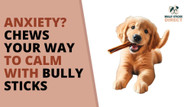Anxiety? Chews Your Way to Calm with Bully Sticks
Posted by Greg C. on Oct 14, 2024
Dogs can experience anxiety just like humans, something every pet parent recognizes. Whether due to separation, stress, or unfamiliar environments, these anxious behaviors can be troubling. Fortunately, there are several strategies to help manage it, and bully sticks are one very popular solution. These natural chews not only support dental health but also help calm dogs, particularly those dealing with separation anxiety or stress.
Understanding Dog Anxiety: The Role of Bully Sticks
Before discussing how bully sticks can help, it’s important to understand the underlying causes of anxiety in dogs. Though all dogs may experience anxiety at times, particular triggers can escalate these feelings into more severe cases. Common causes include:
- Separation Anxiety: A leading cause of anxiety in dogs, this occurs when a dog feels extreme anxiety or distress when left alone or away from their owner. Usual signs include excessive barking, destructive behavior, and escape attempts.
- Noise Sensitivity: Canines may become anxious in response to loud noises, including construction sounds, thunderstorms, or fireworks.
- New Environments or Situations: Some dogs may experience stress when faced with changes in their environment, such as the arrival of a new baby or pet or moving to a new home making it hard for them to resume normal daily activities.
- Medical Conditions: Anxiety can sometimes be a sign of underlying medical problems, such as chronic pain or conditions related to aging.
In addition to these specific causes, there are general risk factors that apply to all anxiety disorders in dogs, providing a broader context for understanding who may be at risk.
Regardless of the cause, it is essential to find ways to help your dog feel more secure and calm. This is where bully sticks can come into play.
What is Dog Anxiety?
Pup anxiety is a common behavioral challenge for many pet owners, often manifesting as fear or worry. This can lead to behaviors like whining, barking, pacing, or even destruction. Similar to humans, dogs can experience occasional anxiety due to triggers like environmental changes, separation, loud noises, or social interactions. When this anxiety becomes chronic and interferes with daily life, it may be diagnosed as an anxiety disorder. It's important to understand the difference between occasional anxiety and a more serious disorder to provide the right care for your four-legged friend.
Types of Anxiety Disorders in Dogs

Dogs can suffer from several types of anxiety disorders, each with its own set of triggers and symptoms:
Separation Anxiety Disorder: This is one of the most common anxiety disorders in canines. It happens when dogs become extremely distressed when separated or left alone from their owners. Symptoms often include excessive barking, attempts to escape, and or destructive behavior.
- Generalized Anxiety Disorder: Dogs with this disorder exhibit excessive and persistent worry about everyday situations, such as encountering loud noises or unfamiliar people. This constant state of worry can significantly impact their quality of life.
- Panic Disorder: Characterized by sudden and intense episodes of fear or anxiety, panic disorder in dogs often comes with physical symptoms like panting, pacing, and trembling. These episodes can be very distressing for both the dog and the owner.
- Social Anxiety Disorder: Dogs with social anxiety disorder experience fear or anxiety in social situations, such as meeting new people or other dogs. This can lead to avoidance behaviors and make social interactions challenging.
Recognizing these different types of anxiety disorders can help in identifying the specific issues your dog may be facing and seeking appropriate treatment.
Recognizing the Signs of Dog Anxiety
Identifying the signs of dog anxiety is the first step in providing the needed support and treatment. Common signs to watch for include:
Barking or Whining: Excessive vocalization can be a sign of anxiety, especially if it occurs when the dog is left by itself or in stressful situations.
- Pacing or Restlessness: An anxious dog may have difficulty settling down and may pace back and forth.
- Destructive Behavior: Digging, chewing, or other destructive actions can be a way for dogs to cope with their anxiety.
- Escaping or Attempting to Escape: Dogs may try to run away or escape from situations that cause them stress.
- Panting or Trembling: Physical symptoms like panting, trembling, or shaking can indicate intense anxiety.
- Avoidance: An anxious dog may avoid certain environments, situations, or people that trigger their anxiety.
If you notice these signs in your dog, it’s critical to consult with a veterinarian or a certified animal behaviorist. They can help rule out any underlying medical conditions and develop a comprehensive treatment plan tailored to your dog’s needs.
Why Bully Sticks?
Crafted from the pizzle (muscle) of cattle, thick bully sticks are all-natural chews for dogs, known for their durability and digestibility compared to other types of chews like rawhide. They are free from additives and artificial preservatives, promoting both physical well-being and mental stimulation, making them helpful for reducing anxiety in dogs.
The Chewing Instinct and Its Calming Effects
Dogs have an instinct to chew. Chewing helps reduce stress for pups, much like how humans find comfort in activities like knitting or squeezing a stress ball. The action of gnawing releases endorphins, natural brain chemicals that promote a sense of contentment. These endorphins serve as a natural stress reliever, calming their anxiety.
By giving a dog a bully stick, they can focus on chewing, which takes their mind off the stressor causing their anxiety. Whether it's the fear of being alone or reacting to a noisy environment, the act of chewing helps calm and soothe them.
Separation Anxiety Disorder and the Role of Bully Sticks
One of the most difficult forms of anxiety to manage is separation anxiety. Dogs with this condition feel distressed when their owners leave, often resulting in destructive habits or constant barking. Though training and behavior modification is needed for lasting improvement, bully sticks offer an immediate, calming solution.
Offering your dog a bully stick before you go gives them something positive to focus on. Its long-lasting nature makes sure they stay occupied, which can help reduce anxiety by diverting their attention from your absence to the satisfying activity of chewing.
Connecting your departure with a rewarding experience, such as giving a bully stick, can help your dog feel less anxious over time. They come to expect something enjoyable when you leave, creating a positive association.
Stress Relief in Intense Anxiety Situations
Even if a dog doesn’t have chronic anxiety, they might feel stressed in particular situations, such as vet visits, loud sounds, or when houseguests arrive. In these instances, bully sticks can be a useful tool for minimizing stress.
Instead of comforting your dog with words or petting, which may not always help, offering them a bully stick offers a productive way to focus their energy. Chewing engages their mind and helps reduce anxiety. For dogs especially sensitive to noise, giving them a bully stick during thunderstorms or fireworks gives them a positive distraction, lowering their fear.
Enhancing Mental Stimulation with Bully Sticks
Mental stimulation is critical for reducing anxiety, particularly in dogs with separation anxiety. Dogs left alone often feel bored or lonely, and bully sticks offer enrichment that benefits their mental and physical health. Boredom can lead to anxious habits, but with a stimulating chew, dogs are more likely to stay calm and at ease.
Giving your dog a challenging chew like a bully stick helps them channel their energy into something productive, preventing them from being overwhelmed by anxiety. This mental stimulation can reduce anxiety-driven behaviors, such as pacing or destructive chewing on furniture.
Creating a Calm Environment
Creating a calm and secure environment is vital for reducing your dog’s anxiety and stress levels. Here are some practical tips to help your dog feel more relaxed:
- Provide a Quiet Space: Ensure your dog has a comfortable and quiet area to retreat to, such as a crate or a designated room.
- Use Calming Aids: Pheromone diffusers, calming music, or white noise machines can create a soothing atmosphere for your dog.
- Minimize Environmental Changes: Try to keep your dog’s routine consistent. Sudden changes, like a new work schedule or moving to a new home, can increase anxiety.
- Regular Exercise and Mental Stimulation: Daily walks, playtime, and interactive toys can help reduce stress and keep your dog mentally engaged.
- Consider Anti-Anxiety Medications or Supplements: Under the guidance of a veterinarian or a certified animal behaviorist, you might explore anti-anxiety medications or natural supplements like bully sticks to help manage your dog’s anxiety.
By creating a calm environment and being attentive to the signs of anxiety, you can help your dog feel more secure and reduce the risk of developing anxiety disorders.
How to Use Bully Sticks for Generalized Anxiety Disorder Relief
Now that we’ve covered how bully sticks can help with anxiety, let’s explore some practical tips for incorporating them into your dog’s routine:
- Timing Is Key: For dogs dealing with separation anxiety, offering a bully stick shortly before you leave can help create a positive connection between your departure and the chew. This can help your dog focus on the present moment rather than perceived threats, which are often disproportionate to the actual danger.
- Supervised Chewing: Even though bully sticks are usually safe, you should always monitor your dog while they’re chewing to reduce the risk of choking or overeating.
- Limit Chewing Time: By restricting chewing sessions to about 30 minutes, you can help prevent overuse and digestive problems, ensuring your dog doesn’t consume excessive amounts at once.
- Store Properly: Proper storage is essential to maintaining the freshness of bully sticks. Keep them in a cool, dry place or an airtight container so they stay safe and enjoyable for your dog.
- Combine with Training: When dealing with severe anxiety, bully sticks should be paired with behavior modification strategies like desensitization and counter-conditioning. Consulting a professional trainer can help develop a program that addresses the root issues of your dog’s anxiety.
Wrapping up
Bully sticks offer a natural and engaging method for managing your dog’s anxiety, especially for those dealing with temporary stress or separation anxiety. Their long-lasting nature provides mental stimulation and calming chewing action, helping dogs stay focused and calm during stressful times. While not a complete solution, bully sticks can be an important part of an in-depth approach to reducing anxiety, helping your dog feel more secure and content. By adding bully sticks to your dog’s routine, you offer a safe and healthy outlet for their anxious energy.



